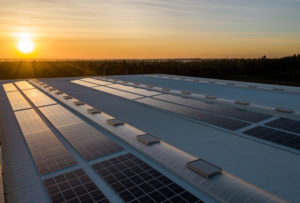OpEds
Why the light at the end of SA’s dark tunnel is distinctly green
Without doubt, the biggest talking point in South Africa right now is the national energy crisis.
Over the past few days, Eskom has implemented Stage 6 loadshedding, meaning it has cut 6 000MW from the national grid. To put that into perspective, this is more than 10% of the entire combined generation capacity of the country.
Aside from not being able to watch Netflix or warm up a “Woolies meal”, the country loses about R4 billion each day that we are in Stage 6 loadshedding. Large businesses experience millions in losses due to wastage and shutdowns; small, medium and micro enterprises either have to close or run expensive generators just to keep operating; and city centres become gridlocked without traffic lights.
Suffice to say, the energy situation in South Africa is nothing short of a crisis. The question is, what now?
Just as necessity is the mother of invention, desperation is the father of opportunity.

It’s becoming ever clearer that the only sustainable way to bolster South Africa’s energy generation capacity is by making use of private energy producers. From its inception in 2010, the Independent Power Producer (IPP) programme has allowed for private entities to build power plants using a variety of different energy sources and supply that energy to Eskom. To date, this programme supplies just more than 10% of our national grid.
South Africa is blessed with tremendous potential in the renewable energy space. With more than 2 500 hours of sunshine each year, and coastlines which provide a consistent source of wind, it’s no surprise that the majority of these independent power producers are making use of these resources to provide our national grid with clean, reliable energy – just nowhere near enough of it.
It seems logical that one clear, theoretical, solution to South Africa’s electricity woes is to expand on the microcosm of the IPP programme, and endorse it to become a programme that supplies the vast majority of our national grid rather than merely a fraction of it.
So, how do we get there?
The government has already amended its energy plan to allow private entities to build infrastructure to feed excess solar power back into the grid. This was coupled with an increase in the maximum size of a solar system that companies would be allowed to put on their roof without a generation licence.
What this means is that businesses and households will be able to install solar energy systems at their premises not only to produce their own cheaper, more reliable electricity, but also to be paid for any excess electricity they produce. That would then incentivise them to install larger systems than they might have required previously, and to become mini power producers for the national grid.
At this point you may be wondering, with all these exciting initiatives coming into play, why am I still stuck without power for half the day?
Unfortunately, IPPs are being approved more slowly than the demand for them rises. Actual legislation is still yet to be passed with respect to homeowners and businesses being able to supplement the grid.
Eskom’s infrastructure is too frail to withstand the fluctuating influx of power that will come from larger businesses feeding back into the grid, especially on weekends, when it uses less of its own power.
If all goes well, we’re still a few years away from being able to see the benefits of these measures.
Okay, so what do we do now? The answer is quite simple, look after yourself.
This may sound selfish, but bear in mind the big picture. Solutions for homes, businesses, and industry – to become less reliant on the struggling national grid – are becoming more and more accessible.
By making use of our abundance of clean energy sources, we have an opportunity to keep the lights on at home, for businesses to carry on operating at full capacity, for industry and trade to continue to grow and flourish, all while making a significant impact on reducing our carbon footprint.
If South Africans can adopt this mentality, we’ll not only be looking after ourselves, but also laying the stepping stones for the inevitable end game of government privatising the generation of electricity, and allowing Eskom to shift its focus to distributing and transmitting that power efficiently.
To sum up, while it may all seem like doom and gloom, there’s a tremendous amount of potential in the future of South Africa’s energy plans and developments.
We could soon see South Africa become a hub for sustainable, green energy supplied reliably and affordably by multiple independent producers. Even if we’re a decade or so late.
- Erin Berman-Levy is an industrial engineer and chief executive of Blue Echo Energy, a company that specialises in providing innovative renewable energy solutions.
yitzchak
September 22, 2022 at 6:49 pm
New movie showing at a bioscope near you!(direct from the Emalahleni-witbank stage)
MAN OF LA MANTASHE:
Julius Malema featured as Dom Quixiote tilting at the Turbines
Andre de Ruiter playing his cervantes as Sancho pansella trying to keep things logical.
Poor old Gordham in a gordian knot unsure of the future.
Gwede playing himself but in the dark about everything and cajoling Independent Powder Producers.